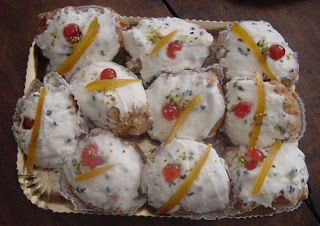Do you know what a genovese is in Sicily? It is a pastry filled either with ricotta cream or a very delicate milky-custard cream. The most famous genovesi, at least in the western part of Sicily, are the ones made in the medieval village of Erice, in the province of Trapani. They are delicious, soft and tasty, especially if eaten warm. Here there is the recipe of the genovesi made by the famous Patisserie of Maria Grammatico in Erice.
Ingredients and preparation:
Pastry
Pastry
250 g hard wheat flour
250 g flour 00
200 g sugar
200 g butter or margarine cut in pieces
4 yolks
Some table spoons of cold water
200 g sugar
200 g butter or margarine cut in pieces
4 yolks
Some table spoons of cold water
icing sugar to sprinkle on top
Filling:
2 yolks
150 g sugar
40 g starch (wheat or corn)
½ lt milk
grated lemon zest
150 g sugar
40 g starch (wheat or corn)
½ lt milk
grated lemon zest
Pastry preparation:
 1. Mix both the two flours with the sugar in a large bowl.
1. Mix both the two flours with the sugar in a large bowl. 2. Add the pieces of butter, then the yolks one after another, stirring slowly with a professional spatula. 3. Add the water until the pastry is soft and elastic. 4. Form a ball without kneading too much otherwise it will get hard. 5. Wrap the pastry in plastic and place it in the fridge for at least 30 minutes. 6. Roll it out giving them an oval shape, like shown in the picture.
Cream preparation and baking
1. Preheat the oven at 200° degrees.
2. In a bowl beat the yolks with the sugar using a whisk.
3. In a sauce pan on a low heat melt carefully the starch in a half glass of milk, then add the remaining milk and mix well.
4. Pour the mix of yolks and sugar into the milk slowly. Keep stirring for 10-15 minutes, until it becomes solid and smooth. Add the grated lemon zest.
6. Once is cold take a couple of spoons of cream and fill the oval shaped pastries, one after another (about 2 cm in diameter). Then stick together the two parts giving the shape of half moon, like in the picture.
7. Once they are all filled, place them on an oven tray and bake them for 8-10 minutes (200° C) at the most. You should have about 15 genovesi.
8. Finally, sprinkle with icing sugar and serve while still warm. Enjoy!












